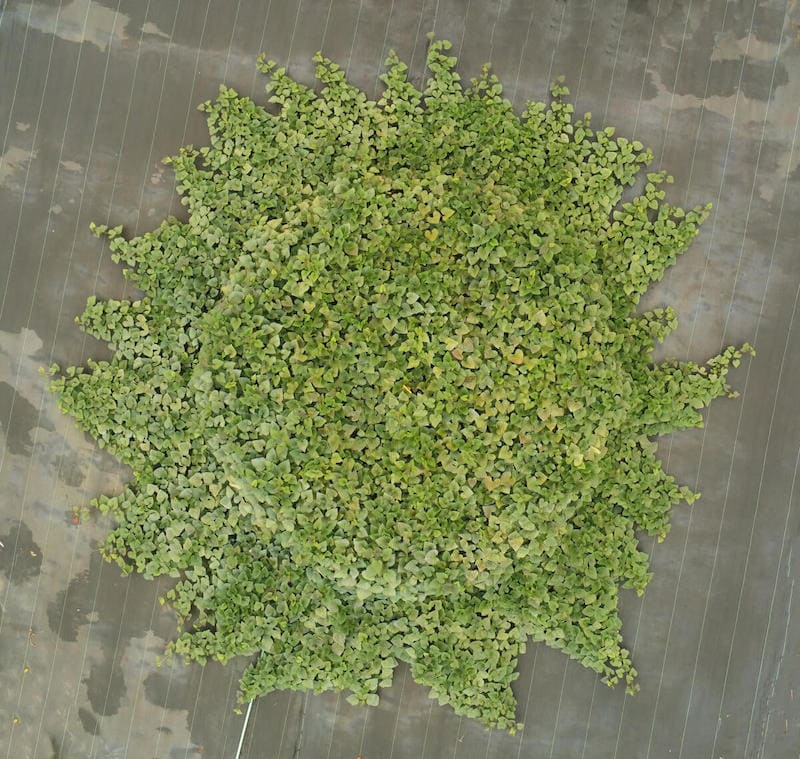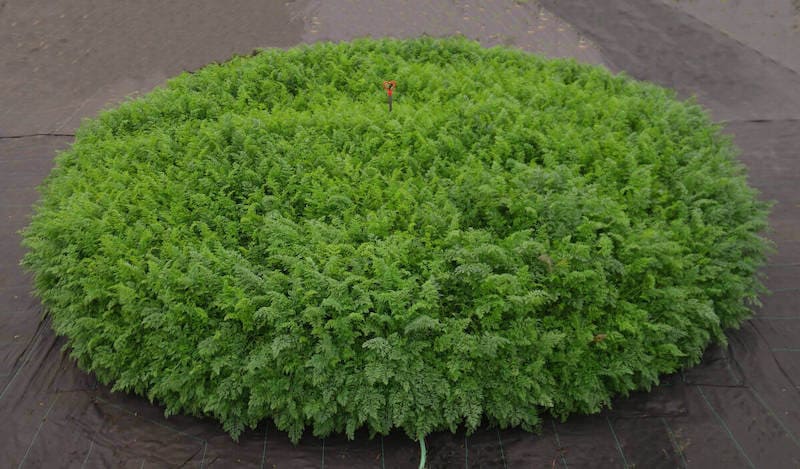
Crop Circle Raised Gardens are designed to grow huge amounts of root vegetables in an incredibly small space. Because they use an off-site growing medium, they can grow root crops just about anywhere; a community garden, on top of a parking lot, an empty city lot – even a rooftop.
Crop Circle Raised Gardens ® are panelized rings that create a 15-foot, soil filled elevated circle for high-density root crop plantings. These raised gardens assemble quickly; set up takes just 30 minutes. Once assembled, the interior cavity is filled with a mix of aged animal and plant compost. A movable stretch ramp extending over the soil circle provides access for seeding and weeding.
Soil Control – Soil consistency is of paramount importance for growing the best root crops. To grow properly formed root, the soil must be loose, loamy, and drain well.
Nutrient Control – A proper mix of fertilizer is essential. Aged plant and animal compost mixed thoroughly with the soil will grow great root crops.
Water Control – Plants are intermittently irrigated using an elevated 360-degree butterfly spray nozzle at the center of the circle, which saves a tremendous amount of water, vital for regions with water scarcity issues.
Grow Anywhere – Growing food anywhere makes this system an invaluable “point-of-use” plant propagation system capable of growing root crops right where people live and work.
Plant And Forget – Once the Crop Circle Raised Garden is set up and operating, it becomes a “plant-and-forget” farm system growing plants unmonitored for weeks until harvest.
Weed Control – High density planting chokes out weed growth after a week or two creating a "no-weed" growing environment during the growth cycle.
Seeds are broadcast from the ramp using our proprietary Crop Circle Seed Dispenser, which spaces seeds at the proper distance eliminating the need for plant thinning. A layer of compost half of an inch deep covers the seeds after broadcasting. Soil and seed are then watered from above using our proprietary Crop Circle Spray Nozzle mounted on top of a vertical riser at the center of the raised garden. The lower end of the riser is connected to a horizontal pipe with a receptacle mounted at the raised garden edge were a garden hose attached to the receptacle supplies water for the raised garden.
At harvest, plants are simply pulled in bunches by hand from the soil after disassembling the panels.
Typically, potatoes are hilled in the garden or trenched in a farm field. With each method, a portion of the surrounding soil is used to partially bury potato plants to encourage potato development along the buried length of the stem. In practice, the deeper a potato stem is buried, the more potatoes will be grown by the plant, however there is a limit to this. Depending on soil type, maximum stem depth ranges between 12 and 16 inches. Thought must be given to how this backfilling is done. There must be adequate spacing between plants (spacing between plants of 3 feet is typical) to provide access for hand and/or machine tilling and backfilling. Commercially, potato plants are watered from above using a spray irrigation system. At harvest, potatoes are dug out by hand or mined with a potato plow.
Two types of potatoes are be grown in a Crop Circle Raised Garden: Sweet potatoes and Root potatoes.

Crop Circle Raised Garden panels are assembled on top of a prepared flat soil surface. In some instances, a ground cover is used to prevent weed growth around the raised garden. After assembly, the 20-panel circle forms a cavity, which is filled with growth medium. The best soil for growing potatoes is a loose, granular loam mixed with aged plant and animal compost. Adding specific fertilizers in layers will grow large numbers of perfectly shaped potatoes.
When a ground cover is used, a circle is cut out of the center of the ground cover six inches inside the perimeter of the assembled panels. This will allow seed potatoes to put down roots through the existing soil below grade. Approximately 200 seed potatoes are placed on top of the soil within the cut circle and covered with 3 consecutive layers of growth medium mixed with potato fertilizer until the cavity of the raised garden is filled to within an inch of the top edge. The lowermost layer should be high in Potassium, which improves the storage life of a potato. The middle layer should be high in Phosphorous, which increases the number of tubers (potatoes) per plant and the uppermost layer should contain Nitrogen to assist in early plant development.
Approximate 500 potato plants will emerge from the depths of the cavity after 10 days or so. As the plant grows and flowers, tubers will form along the length of each stem and produce approximately 5,000 potatoes. An early harvest will reap new potatoes. Leaving them in the soil to mature allows them to develop a thicker skin, which is desired for long-term storage.
It is common practice to cover a flat, level ground surface with a ground cover to prevent weed growth inside and outside the grower before panel assembly. Because sweet potatoes form just below the soil surface, cutting a circle out of the ground cover inside grower is not required. The cavity is filled with soil a third of the way to the top. A nutrient rich mixture of growth medium containing Phosphorus, Potassium and Nitrogen fill the other two thirds to within an inch of the top edge. Approximately 200 potato slips are then transplanted a foot apart from one another across the surface of the growth medium.
A 360-degree Crop Circle Spray Nozzle mounted on a vertical riser at the center of the raised garden waters the sweet potato plants.
Sweet potato slips are delicate, so it is important that they be hardened off outdoors in the natural sun before transplant. A few weeks after transplant they will start to vine, first on top of the growth medium, then down over the sides of the grower and across the surrounding ground cover. About 3,000 good-sized sweet potatoes can be expected at harvest after 4 months.
Sweet potatoes need to be cured before they become sweet, which involves placing them in a warm environment (65-85°F) for about a week and then moving them to an area of lower temperature (45-65°F) for 8 more weeks. After that, they can be kept in a root cellar for several months.
Crop Circle Raised Garden panels are assembled on top of a prepared flat and level soil surface covered with a ground cover to prevent weed growth. Once assembled, the 20-panel circle forms a cavity, which is filled with growth medium. The best growth medium for growing carrots is loose sandy loam containing a nutrient rich mixture of aged plant and animal compost. Soil pH should be between alkaline and acidic, somewhere around 5.8 to 6.5. Getting this mix right is important for growing large numbers of perfectly shaped carrots – an incorrect mix will compact the medium and constrain, crook and fork root development.
Before filling the Crop Circle Raised Garden with growth medium, the irrigator assembly is installed, which comprises a vertical riser attached to a horizontal pipe that connects to an external water supply, a garden hose, for example. A 360-degree Crop Circle Spray Nozzle attached to the top end of the riser irrigates the carrots.

An elevated stretch plank is used as an elevated gangway to broadcast carrot seeds on top of the growth medium. Broadcasting seeds with a Crop Circle Seed Dispenser ensures carrot seeds are properly spaced eliminating the need to thin carrots. The plank is also used to pull the handful of weeds that may appear before carrots tops grow thick enough to suppress them. A thin layer of growth medium about one half of an inch thick covers the seeds after broadcast.
Carrots are pulled in bunches by hand after the panels are disassembled. In most growing zones, a second carrot harvest is possible the same season. Between 5,000 and 8,000 carrots may be grown in a Crop Circle Raised Garden every 3 months.
After the season is done, the Crop Circle Raised Garden is disassembled, cleaned, and stored in a dry place. Keeping panels stored during the winter months will ensure that the raised garden components will last for years - as many as 30 if the panels are properly cared for. The groundcover can stay down for 10 or more years before it needs to be replaced. Only the raised garden panels and irrigation system need to be assembled and disassembled each season. The growth medium can either be discarded, replaced, or recharged each season. Creating a second growing area adjacent to the first, allows the 20-panel unit to be disassembled and reassembled from one spot to another, simplifying next season year soil recharging and/or replacement.
Join our partners New Leaf Technologies and Growing To Give to free people from hunger with Crop Circle Raised Gardens across the country and around the world.